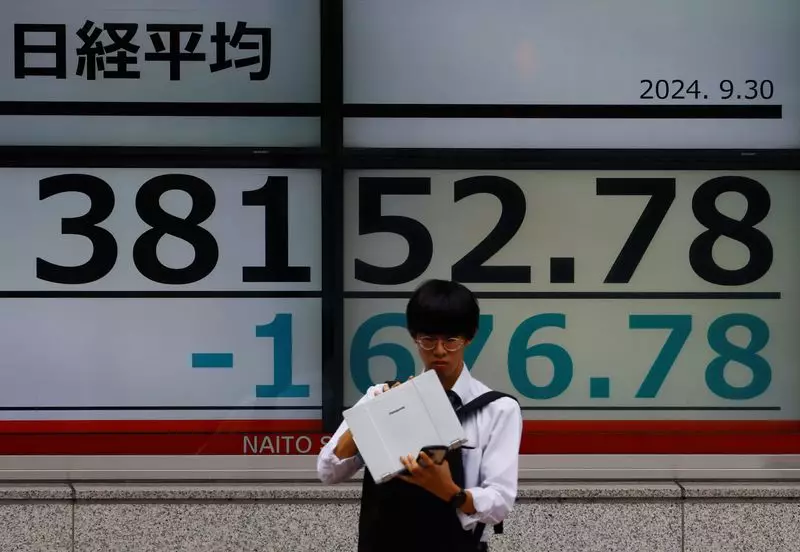On Monday, Asian stock markets experienced a notable upswing, driven primarily by an encouraging U.S. inflation report that has reignited optimism for potential monetary easing in the upcoming year. Investors welcomed the news that Washington successfully averted a government shutdown, adding to the buoyancy in the financial atmosphere. This recent development is particularly significant given the historical context of government shutdowns and their disruptive impact on investor sentiment and market stability.
As we delve into the landscape of financial markets, it becomes evident that the recent shifts represent both a reaction to immediate economic indicators and underlying trends shaped by central bank policies. After several weeks characterized by a flurry of central bank meetings and pronouncements, the forthcoming week appears more subdued, with only the minutes from earlier meetings slated for release. The absence of Federal Reserve speeches and minimal U.S. economic data gives an impression of a temporary lull amidst broader economic narratives.
In the current market environment, the strength of the U.S. dollar remains a focal point of discussion. Underlying this strength is a combination of a resilient U.S. economy and rising bond yields, both of which have exerted downward pressure on commodities, including gold. The dollar index, nearing two-year highs, signifies a robust currency market performance, with projections indicating a 1.9% increase for the month. This rally also brings attention to the vulnerabilities of emerging market economies, which are struggling to stabilize their currencies in the face of increasing dollar dominance.
Indeed, the dollar’s ascendance complicates the financial landscape for countries heavily reliant on exports. A strong dollar can lead to inflationary pressures domestically, prompting several emerging economies to intervene and protect their currency values. Asian stock markets’ responses are often seen as barometers for broader economic health, and the fluctuations in currency can significantly influence investment patterns.
Analysts are becoming increasingly cautious as they assess the equity markets, especially following an impressive year-end rally. While the S&P 500 and other indices have shown promising annual gains, a closer inspection reveals troubling concentration risks. Observations from Bank of America indicate that the S&P 500’s substantial performance is largely attributable to the 12 largest companies. This disproportionate influence amplifies market vulnerabilities, signaling potential volatility going into 2025.
The broader implications of such concentration cannot be overstated. A severe downturn in a few key players could dramatically alter the market’s trajectory as a whole. This points to the critical importance of diversifying investments and monitoring shifts among smaller companies that may hold more growth potential. With predictions of recalibrated interest rates, investors are advised to maintain vigilance and seek a more balanced portfolio going forward.
Inflation Trends and Interest Rate Projections
The recent data revealing a drop in core U.S. inflation, indicated at a modest 0.11%, provided a vital counterbalance to the Federal Reserve’s previously hawkish stance. Market futures now reflect increased optimism, with projections suggesting a 53% chance of a rate cut by March and a growth to 62% by May. However, the overall landscape still reflects a cautious approach, as only two quarter-point cuts are anticipated through 2025.
Further complicating this outlook is the rising bond yield environment, with a dramatic increase in 10-year yields recorded at 42 basis points over a two-week span, marking the steepest climb since April 2022. Such movements indicate a tightening bond market, further enhancing the complexities of monetary policy decision-making. Economic analysts are split on future cuts, with some advocating for a careful approach, while others hint at a more aggressive reduction schedule based on employment and inflation forecasts.
Commodity Performance Under Pressure
The interrelationship between a robust dollar and commodities presents another dimension to the current market analysis. Gold, often seen as a hedge against inflation, fell slightly as the dollar fortified its position. A similar fate befell crude oil, which is grappling with diminished demand signals from China. Despite slight gains, oil remains under scrutiny as global economic conditions continue to evolve.
While Asian markets exhibit a positive trend catalyzed by recent U.S. inflation data, underlying tensions within economic indicators and geopolitical contexts warrant a discerning approach. Investors and analysts must remain alert in navigating this multifaceted landscape, balancing optimism with caution as 2025 approaches. The coming months will undoubtedly reveal more about the health of the global economy and the markets’ capacity to adapt to new challenges.

